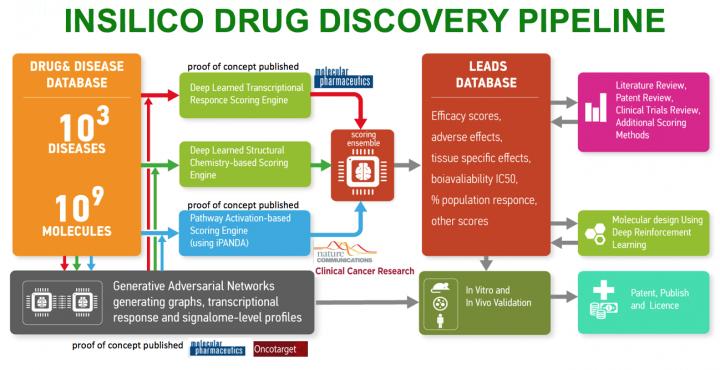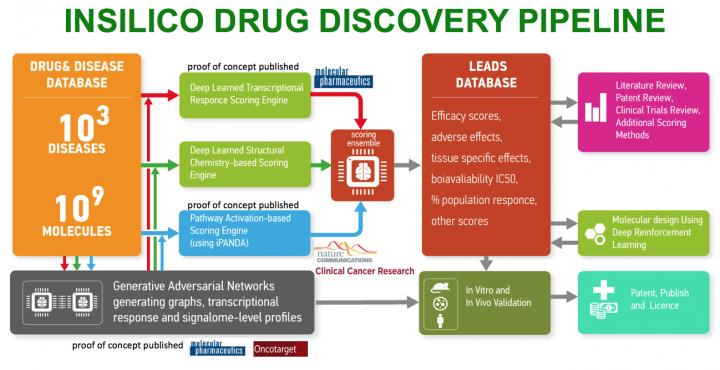
Credit: Insilico Medicine
Wednesday, Nov. 29, 2017, London, UK: Researchers from the Biogerontology Research Foundation, Insilico Medicine, Life Extension and other institutions announce the publication of a landmark study in the journal Aging on the identification of natural mimetics of metformin and rapamycin.
Metformin, a common type 2 diabetes drug, and rapamycin, a common anti-rejection drug, have both been shown to have substantial anti-aging and anti-cancer effects in a variety of model organisms. However, both compounds have known side effects and are regulated drugs for existing disease indications, factors that problematize their off-label use as healthspan extending drugs.
In this study, the researchers applied deep-learned neural networks to profile the safety and gene- and pathway-level similarity of more than 800 natural compounds to metformin and rapamycin, in an effort to identify natural compounds that can mimic the effects of these anti-cancer and anti-aging drugs while remaining free of the adverse effects associated with them.
"Earlier this year we launched Young.AI, a comprehensive system utilizing the recent advances in deep learning for tracking a variety of aging biomarkers. I hope that the consumers using the Longevity A.I. will start using it. One of the goals of our group is to identify the combinations of molecules that achieve the desired effects" said Alex Zhavoronkov, PhD, co-author of the study, founder of Insilico Medicine and Chief Science Officer of the Biogerontology Research Foundation.
Their analysis identified many novel candidate metformin and rapamycin mimetics that have been previously unreported as such. In particular, they identified allantoin and ginsenoside as strong mimetics of metformin, epigallocatechin gallate and isoliquiritigenin as strong mimetics of rapamycin, and withaferin A as a strong mimetic of both. Additionally, their analysis also identified four previously unexplored natural compounds as fairly strong mimetic of rapamycin.
"Aging is not recognized as a disease, so we need strong potential geroprotectors of natural origin on the market. Supplements that slow down aging, affecting the key mechanisms of aging at the molecular and cellular level" said Alexey Moskalev, PhD, a co-author of the study.
These findings are significant because, as naturally occurring compounds, such nutraceuticals are not subject to regulation by the FDA and other regulatory bodies. Furthermore, because the researchers induced a deep-learning based classification of the safety profiles associated with these compounds, the novel candidate mimetics the study identified are likely to have less adverse effects than metformin and rapamycin, though this needs to be further validated by clinical testing.
"This study is significant not only for the identification of novel candidate mimetics of metformin and rapamycin, which as natural compounds are not subject to regulatory bodies like the FDA and which have higher-scoring safety profiles as indicated by our deep-learned safety profile classification analysis, but also for demonstrating particularly powerful screening methods that can be applied to the identification of novel and safe mimetics of other known anti-cancer and healthspan-extending drugs and compounds" said Franco Cortese, co-author of the study and Deputy Director of the Biogerontology Research Foundation.
###
The paper can be accessed at http://www.aging-us.com/article/101319
About the Biogerontology Research Foundation
The Biogerontology Research Foundation is a UK non-profit research foundation and public policy center seeking to fill a gap within the research community, whereby the current scientific understanding of the ageing process is not yet being sufficiently exploited to produce effective medical interventions. The BGRF funds and conducts research which, building on the body of knowledge about how ageing happens, aims to develop biotechnological interventions to remediate the molecular and cellular deficits which accumulate with age and which underlie the ill-health of old age. Addressing ageing damage at this most fundamental level will provide an important opportunity to produce the effective, lasting treatments for the diseases and disabilities of ageing, required to improve quality of life in the elderly. The BGRF seeks to use the entire scope of modern biotechnology to attack the changes that take place in the course of ageing, and to address not just the symptoms of age-related diseases but also the mechanisms of those diseases.
About Insilico Medicine
Insilico Medicine, Inc. is a bioinformatics company located at the Emerging Technology Centers at the Johns Hopkins University Eastern campus in Baltimore, with R&D resources in Belgium, Russia, and the UK hiring talent through hackathons and competitions. It utilizes advances in genomics, big data analysis and deep learning for in silico drug discovery and drug repurposing for aging and age-related diseases. The company pursues internal drug discovery programs in cancer, Parkinson's, Alzheimer's, ALS, diabetes, sarcopenia and geroprotector discovery. Through its Pharma.AI division, the company provides advanced machine learning services to biotechnology, pharmaceutical, and skin care companies. Brief company video: https://www.youtube.com/watch?v=l62jlwgL3v8.
About Life Extension
A trailblazer in the $35 billion U.S. dietary supplement industry for the past 36 years, Life Extension's core mission is to extend the healthy human life span using an integrative approach by reporting on and funding cutting-edge scientific research. Life Extension Foundation Buyer's Club, Inc. ("Life Extension") offers a full-range of premium-quality vitamins, minerals, and hormones as well as unique, specially made formulas. The company's products are developed based on the latest scientific studies from peer-reviewed medical journals and are continually updated as new information occurs. To learn more about Life Extension, visit http://www.lifeextension.com/
Media Contact
Charlotte Casebourne
[email protected]
@bgrf_uk
http://bg-rf.org.uk
Related Journal Article
http://dx.doi.org/10.18632/aging.101319





